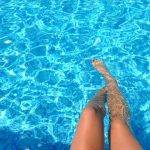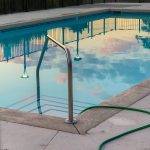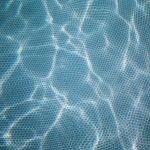This guide covers smaller pools that have the advantage of a simple water change if ever needed. Seasonal pools on TFP are described as following
- Above ground pool with less than 3000 gallons
Pool where the liner can simply be put into place wrinkle free without the weight of the water- Pools that are or could be completely drained and stored each winter
If your pool does not fit the three above guidelines then you will be better off following the guidelines as described in Pool School. Water chemistry for small pools follows the same basic premise as it does for large pools: maintaining a minimum level of chlorine for sanitation and algae prevention, and protecting chlorine from rapid degradation from sunlight buy using a chlorine stabilizer. There are numerous components to pool water chemistry; this document provides only the most basic outline to maintain clear, sanitized water.
A few things to always remember
- Maintaining clean, sanitized, water requires a few minutes of daily testing and adjustment. Get into the habit of checking the pool every day right from the beginning.
- All chemical additions should be made while the pump is running. Dry chemicals should pre-dissolved in a bucket of water before adding into the water. Failing to do this can make the liner brittle and it crack.
- Filters for these pools are disposable . . . stock up on them. Plan to change them every couple of weeks as recommended by your pool documentation and more frequently if problems arise.
- Chlorine levels drop somewhat during the day due to sunlight. Chlorine levels also drop when in the presence of organic materials (algae, bacteria, etc.) that appear in the water (in other words, as chlorine does it’s job, it is used up). How rapidly chlorine levels drop depends on several factors – two important ones are how much stabilizer (CYA) is present and how many people are using the pool. Think of CYA as “sunscreen” for chlorine.
Step 1
You will need a simple 2way test kit that can commonly be found at your local MegaMart. This will allow you to test your pH level and your Chlorine Level. This test kit runs around $10.
Step 2
Using the chart in your owner’s manual, determine how many gallons your pool is. You may also be able to find this information on the manufacturer’s website or you can use the Pool Volume calculator in Poolmath.
Step 3
For this step you will need Cyanuric Acid (CYA) to help protect the chlorine from the sun. This too can be found commonly at the local MegaMart sold in 3lb or 4lb containers. Using the PoolMath calculator add enough CYA to raise your level to 40PPM. With this being a “fresh fill” your CYA level will be zero to start with, so there is no need to test at this point.
Step 4
Test your pH level, and using the PoolMath calculator adjust the level to be between 7.2-7.8.
Step 5
Next test your Chlorine level, and adjust to 4ppm. Using unscented household bleach daily raise your FC level to sanitize your pool.
Step 6
Daily you should test and adjust your pH and Chlorine level to make sure the levels stay at a good rate for pool care. To do this test using your OTO kit and PoolMath calculator. Make sure your Chlorine level always stays above 3ppm at all times. Failing to keep the pool properly sanitized will quickly result in green water. Pumps and filters in these pools are often undersized and make it very difficult to clear once the water starts to turn cloudy. By keeping your chlorine levels above 3 at all times will help kill off any organics in the water.
Step 7
If for any reason the water becomes cloudy or green, drain the water and scrub with a solution of 1 part bleach to 10 parts water. After that start over from Step 3.
Special circumstances
- If your chlorine drops to zero, plan to SLAM your pool using bleach. Calculate how much bleach you need to raise your chlorine level to 12 and add that much in the evening.
- If the water begins turn cloudy or greenish, or pool the surfaces becomes slippery an algae bloom is likely starting to take hold. It is difficult (but not impossible) to resolve an algae bloom with the equipment included in these types of pools. Often, the easiest and quickest solution is to drain the pool, scrub the sides and bottom thoroughly, and start over. If you choose that route, start over with the water chemistry just as you did the first time.
- If draining the pool doesn’t appeal to you, you need to plan on investing in a top-quality test kit (see this article at pool school for comparisons of the three test kits TFP recommends) — all three are generally only available on-line so you’ll need to plan a couple of days for shipping. Come back to the forum, read pool school two or three times, and post your questions. We’ll help you out. If a top-quality test kit isn’t an option, your best best is to drain the pool. We won’t be able to do much for you without the information the advanced test kits provide.
Further recommendations
The pH and chlorine test kit is the very, very basic necessity. If you want to learn more about your water chemistry, and/or you’re using this small pool as a “starter pool” before jumping into a more permanent pool, consider a more advanced test kit. A good intermediate test kit is the HTH 6-way test available at your local MegaMart. In addition to chlorine and pH, it tests total alkalinity, calcium hardness, and CYA (enough for two tests). Recommendations for the best option in test kits can be found in this article at pool school.





